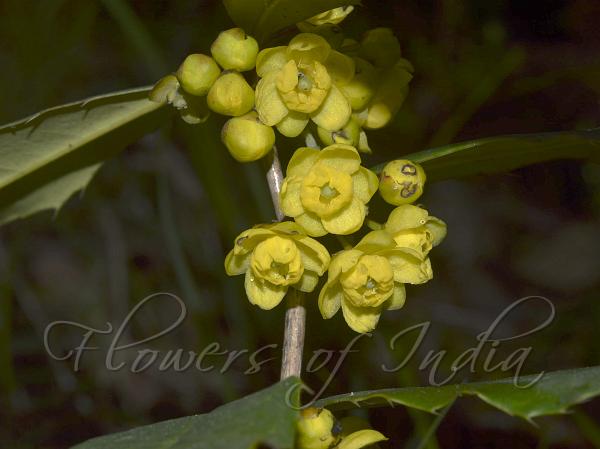|
| East-Himalayan Barberry |
|

|

| File size | 398803 |
| Original date | 5/13/18 12:32 PM |
| Resolution | 0 x 0 |
| Flash | Flash fired, return detected |
| Focal length | 60.0mm |
| Exposure time | 1/200s |
| Aperture | 16.0 |
| Focus Distance | |
| Metering Mode | Multi-segment |
| Camera make | NIKON CORPORATION |
| Camera model | NIKON D3200 |
| Sensor type | OneChipColorArea |
|
|
|
|
Photo: |
Botanical name: Berberis insignis Family: Berberidaceae (Barberry family)
Synonyms: Berberis insignis var. elegantifolia, Berberis insignis var. gouldii
Synonyms: Berberis insignis var. elegantifolia, Berberis insignis var. gouldii
East-Himalayan Barberry is an evergreen shrub, about
1-2 m tall. Stem round or four-edged, dark red to purplish or pale
brownish yellow, hairless, spines absent or 2 fid, few from the lower
nodes, near the base. Leaves are simple, usually 2 or 1-5 in each node,
lanceshaped-elliptic or narrow ovate, 4-16 x 1.5-5 cm across, base
wedge-shaped, margin sawtoothed-toothed with 2-4 mm long many spinules,
tip tapering with spinule tip, papery, leathery, dark green, hairless
or lustrous above, paler beneath, lateral veins 12-20 on either side of
the midrib, nearly stalkless or stalk 3-7 mm long. Flowers are borne in
leaf-axils, in 5-15 flowered racemes or fascicles. Flowers are
bisexual, yellow, about 4-7 mm across, flower-stalks about 8-15 mm
long, sepals 6, in 2 series, outer series smallest and inner series
largest. Petals are 6, obovate or oblong, tip notched. Stamens are
about 1-2 mm long. Fruits are several seeded berries, obovoid,
irregularly netveined on surface, uneven, black when ripe, about 6-8 x
3-4 mm, stylose, style like a cap on top of the fruit. East-Himalayan
Barberry is found in forests edges in Eastern Himalayas, at altitudes
of 2000-3400 m, from Nepal to NE India.
| Identification credit: Bhaskar Adhikari | Photographed in Sandakphu, West Bengal. |
• Is this flower misidentified? If yes,